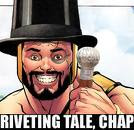
This is my story about me and the unoriginal, but severely important, manifestation of an idea.
Before I was born, my name was determined. My mother had been thinking of names and had a tendency to drift towards T.V. sitcoms for inspiration. Tabatha, Samantha’s daughter on “Bewitched,” was put up for consideration but, thanks to everything holy, my dad was quick to shoot it down. He believed, as I do now, that it was more feline in nature than was preferred. After shopping around a bit more they finally agreed on Bailey Justine McKinney. That is until my grandmother heard it and politely coughed. She could shame a volcano into reversing itself with that cough. I was then Justine Bailey McKinney, in honor of Justine Batemen from the classic “Family Ties” and Bailey from a character on “WKRP in Cincinnati.”
I’ve heard of cultures that revere names like they are the compliment to the soul. To deny your name is to deny yourself. I thought of Rumpelstiltskin even, and the circumstance placed on obtaining his secret name. Protection and pride of this title is expected by many. Pondering these interpretations, I compared my own feelings towards my name to these ideas that names are to be venerated. In comparison, I treat my name like a common whore. I’ve watched it dragged through the proverbial grime and mud on more than one occasion and never lifted a finger to cease the attack. I’ve bore through hundreds of brutal and sometimes insulting mispronunciations without growing cold. I’ve even left it in a back alley, exchanging it for another on a mischievous night of tomfoolery. I dare say that upon meeting one of these people from the aforementioned cultures, things could become quite awkward. To me, my name, which I like by the way, has very little to do with me.
My name has always been a given. It is something that is etched into a jewelry box from my grandmother. It defines me at the D.M.V and correlates with my social security number. It is the sound that is used in reference to me. I remember one night when I was younger, my mother was sitting up with me, attempting to comfort my fears of the storm that wailed and thrashed about outside our home. In my life, organized religion was a semi-presence, but never a theme. Still, at the time I had the basic concept of God, Jesus and all that jazz, and my fear of the tempest conditions outside brought me to think on it a moment. I asked my mom a question. “Why is he called God? Who named him?” She smiled and swept my hair from my face, happy for me to be distracted from the thunder. “Well, I suppose people like you and me named him that so we wouldn’t get confused. It’s just a word for us so we can know who we’re talking about.” I remember these words because they gave me an amazing epiphany when I recalled them with a more able and critical mind. It’s just a noise, this name. A sound of recognition and nothing more. I thought of misunderstandings and wars, fought for different gods without the realization that all of them are intertwined and share so much. Maybe not in name, but in essence. All religions are based on sets of central concepts, but it’s these sounds that create contradiction and with this comes distrust and tragedy. I always hoped to avoid an identity melt down and this concept was central in giving me an amazing sense of self-preservation. A name is but a word used in context. What’s in a name? Absolutely nothing if you ask me.
My journey to self discovery has yet to begin, but I have timidly mapped out my course on the solid foundation that whatever my identity may be, it is not anchored in the words that others call me by. I mean, come on, my mom could have blindfolded herself and pointed to pages in a retro TV Guide. I take great comfort in knowing that whether I’m called Justine, Diana, Marie, or have my name taken from me altogether, I am and always will be the great I am. I am, in every way, Me.














